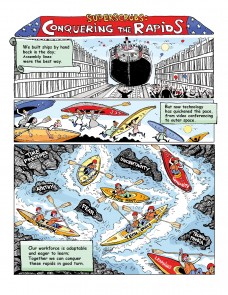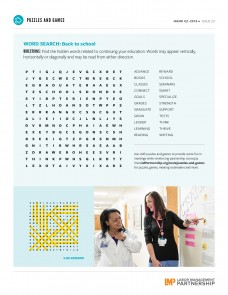Format:
PDF
Size:
11" x 17" (tabloid)
Intended audience:
Managers, union stewards and others who want to promote the workforce development programs offered by Kaiser Permanente and our unions.
Best used:
Print out this tabloid-sized poster to hang in work areas and break rooms.
Download this beautiful infographic, which uses the image of a tree to show how our workforce strategies grow from our roots and reach for the stars.
Format:
PDF
Size:
8.5" x 11"
Intended audience:
Frontline workers, managers and physicans
Best used:
This crossword demonstrates what skills are needed to navigate the future; use it to provide some variety and fun at a team meeting.
Use this crossword puzzle in your next meeting and help your team navigate the future and learn the skills needed in years ahead.
TOOLS
Hank Q1-2018
See the whole issue12 Tips for Building Your Team
Deck
Take one action for every month of the year
Want to take your team to the next level? Make good things happen for yourself, your co-workers and your members and patients? Collaboration is one of the four critical skills needed to meet future challenges with ease. Use these 12 team-building tips to make every month count in 2018.
1. Par-tay
Celebrate your team’s successes and acknowledge — even celebrate — failures. Failures are great opportunities for learning if you focus on where the process (not the person) needs improvement. After each test of change, recognize and reward contributing team members at huddles and meetings. Use small wins to keep the momentum going.
2. In and out
Help employees track their sick days and time off by printing out and distributing our colorful, always popular attendance calendar.
3. Follow the money
Learn your department’s budget as a team and get everyone’s ideas on how to reduce costs. Sign up for a business literacy training.
4. Track it in tracker
Document your team’s work regularly, accurately and concisely in UBT Tracker. It will let others see and learn from your team’s accomplishments.
5. Stop the line
Ask for help or call a stop to the work when you see an imminent danger or need help to safely complete a task. Then look for system improvements and root causes of problems — ask not just what happened, but why.
6. Grow leaders
Rotate responsibilities for leading meetings and managing improvement projects among all team members. This will build your team’s skills and strengths.
7. Two words
Huddle daily. It works. Watch the video “Huddle Power” and use the tools there to get you started huddling with your team.
8. Clean up your act
Become supply savvy. Make a full assessment of supplies — track inventory, tidy up storage areas and streamline ordering. Simple changes can save thousands of dollars. Download our 6S tool to make this work a snap.
9. Take a (waste) walk on the wild side
Perform a waste walk. Impartially observe a work area or work process to identify waste or inefficiency. Get walking with our online Waste Walk toolkit.
10. Save a tree
Go paperless. Don’t print out agendas and documents. Send them out via email or use a projector instead.
11. Get online
Help patients sign up on kp.org. Remind them they can securely view their medical records and most lab results, email their doctors, schedule appointments and refill prescriptions online. Bonus tip: Encourage tech-savvy members to download the kp.org app so they can access these features on their phones. Check out how one team got 90 percent of its patients signed up.
12. Spread and borrow
Did something work for your team? Spread the word to others. Need inspiration for your next improvement project? Look for other teams that have succeeded. Work with your UBT consultant or union partnership representative to spread your successes. Visit our Team-Tested Practices section to get ideas you can try with your team!
Hank Q1-2018
See the whole issueFrom the Desk of Henrietta: A Tale of Two Ankles
I have a friend who loves to play softball. In 1999, she tore her left Achilles tendon while sliding into first base. Her surgery involved getting cut open and then stitched up, which was painful and created a risk of infection. It put her in a heavy cast for six months, left a five-inch scar and was an all-around miserable experience.
Four years later, while playing racquetball, she (you guessed it) tore her right Achilles tendon. In just those few years, surgical technology had improved so much that she could get her leg patched up with laser surgery. She still had to wear a cast — but for only three months this time, and there was no scar. There was hardly any pain. “It was like night and day,” she says.
When someone says, “I don’t want to learn the new way. The old way works just fine,” I tell them about this friend.
Imagine that her doctor and care team had not bothered to learn about the laser surgery. Their patients would have suffered with a longer and tougher recovery than necessary. Caregivers want the best for their patients. That wouldn’t have been the best.
In everything we do, we put the patient and member at the center. Developing the skills of our workforce is no different. We learn new treatment methods to help our patients get better faster. We learn new software programs to help them get their medications more quickly and efficiently. We figure out the new technological gizmos so we can have virtual visits with our members, saving them the time, effort and sometimes discomfort of getting to our brick-and-mortar offices. We invent new ways of doing old jobs, or create entirely new jobs, to meet new needs.
Giving up the old way of doing things is scary, but also liberating. Learning new things can be difficult, but also fun. We’re navigating our way into the future together, supporting one another all along the way.
Hank Q1-2018
See the whole issueMeet Your National Agreement: Change Is Here, Be Prepared
Deck
As health care evolves, so do our skills
In the early 2000s, Blockbuster ruled the video rental roost.
Now it’s all but gone.
Blockbuster didn’t adapt to customer needs and technology trends. Netflix did.
Kaiser Permanente and the Coalition of Kaiser Permanente Unions recognize that if you don’t change with the times, you can get left behind.
The National Agreement addresses the importance of preparing for the future in partnership; section 1D of the agreement covers workforce planning and development.
Under the 2015 agreement, two educational trusts — Ben Hudnall Memorial Trust and SEIU UHW-West & Joint Employer Education Fund — received additional funding to provide workers represented by a coalition union with a variety of services, and training and education programs. Joint work on addressing experience barriers, which have sometimes prevented newly trained workers from being hired into KP jobs, is also under way.
The agreement details the structure for coordinating workforce planning and development. A national team aligns, integrates and coordinates workforce development and training efforts in partnership with the regions. Each region has a workforce planning and development committee chaired by labor and management co-leads.
The five key components of this work are:
- workforce planning and development
- career development
- education and training
- redeployment
- retention and recruitment
“The goal is to prepare union workers for changes to jobs,” says LeAnda Russell, the coalition’s national coordinator for job innovation. “We support the lifelong learning and career development of our workers.”
It’s paying off. Use of the educational trusts has increased to record levels.
Russell encourages employees to keep learning to build the job skills needed as health care evolves. In other words — don’t hit the rewind button. It’s time to press play.
“Technology is here,” Russell says. “Don’t be afraid.”


